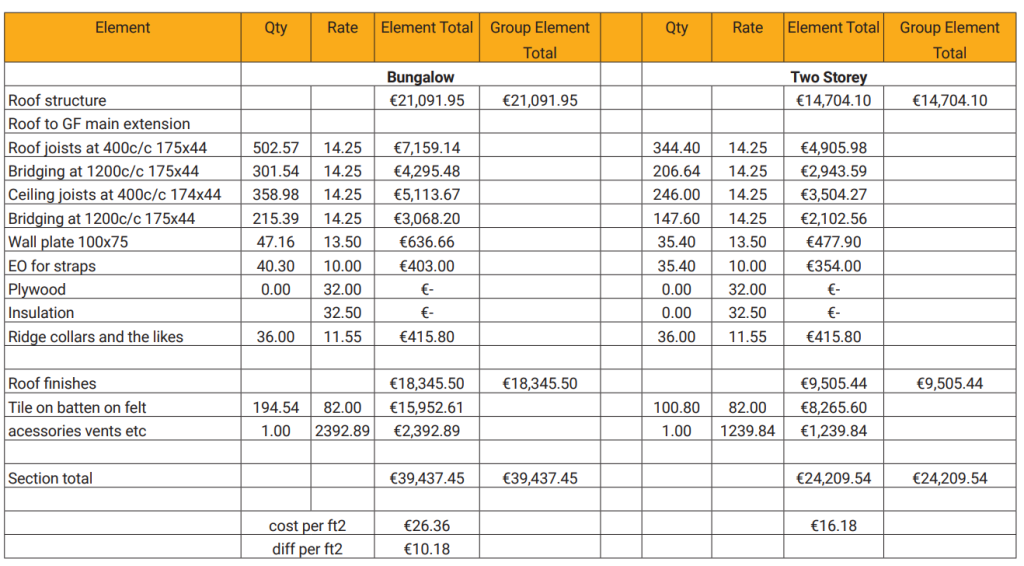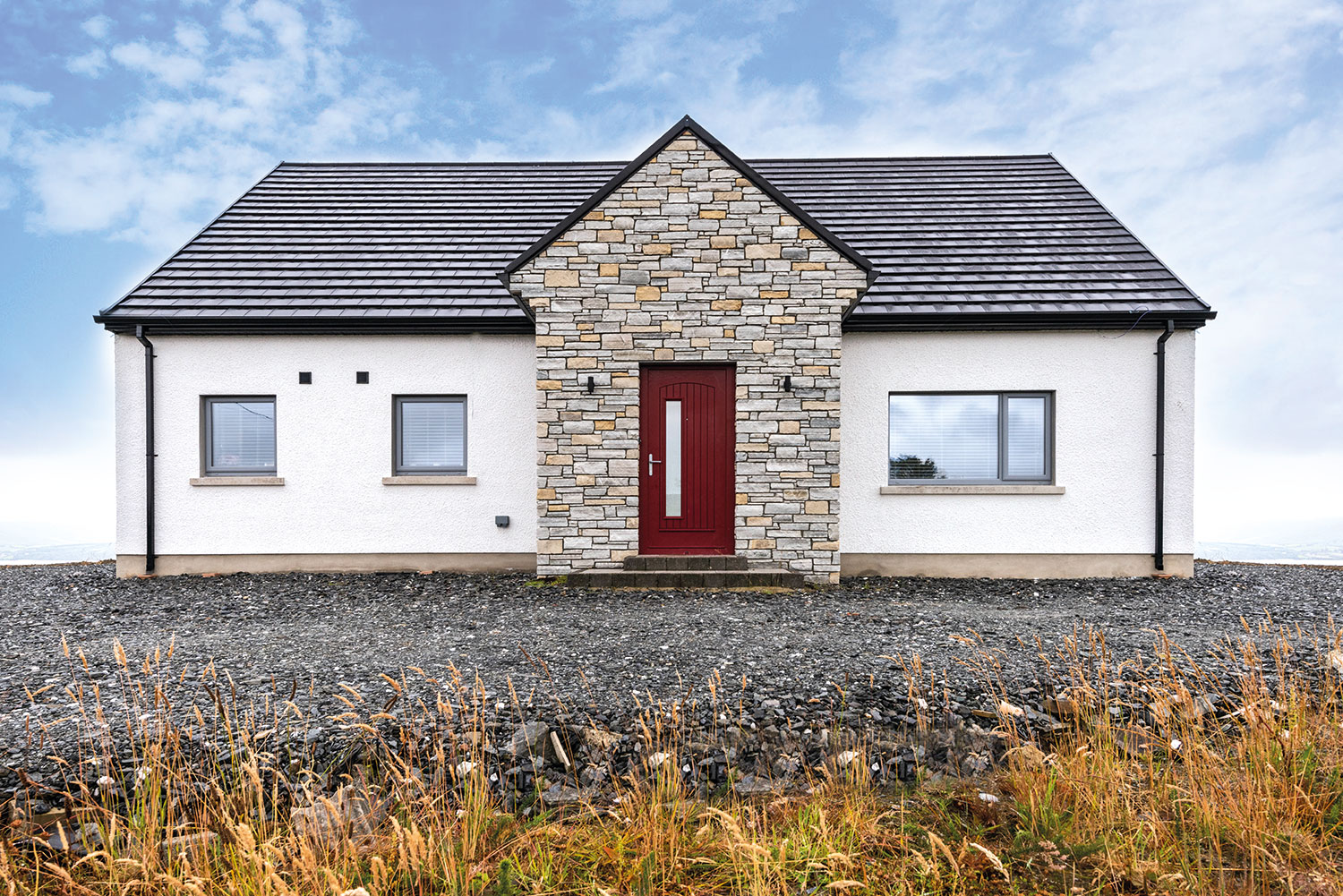Flat versus pitched, bungalow versus two storey, warm versus cold roof, we look at the details of roofing costs.
In this article we cover:
- Overview of how roofs are built and how that impacts on costs
- Cost differences between flat vs pitched roofs for a bungalow
- Roofing cost differences between a bungalow and a two storey house
- Cost component details
- Detailed costs of roof finishes
- Cost of cold versus warm roofs
Four factors influence the type of roof structure selected for a project: size and shape of the building, ridge height, appearance, and installation and maintenance requirements. All of these will have an impact on cost.
Pitched roofs have a slope greater than 10 degrees, although the minimum slope for a pitched roof is usually not less than 15 degrees. The minimum roof slope for concrete tiles is 40 degrees, clay tiles 22 degrees, and slates from 20 to 30 degrees.
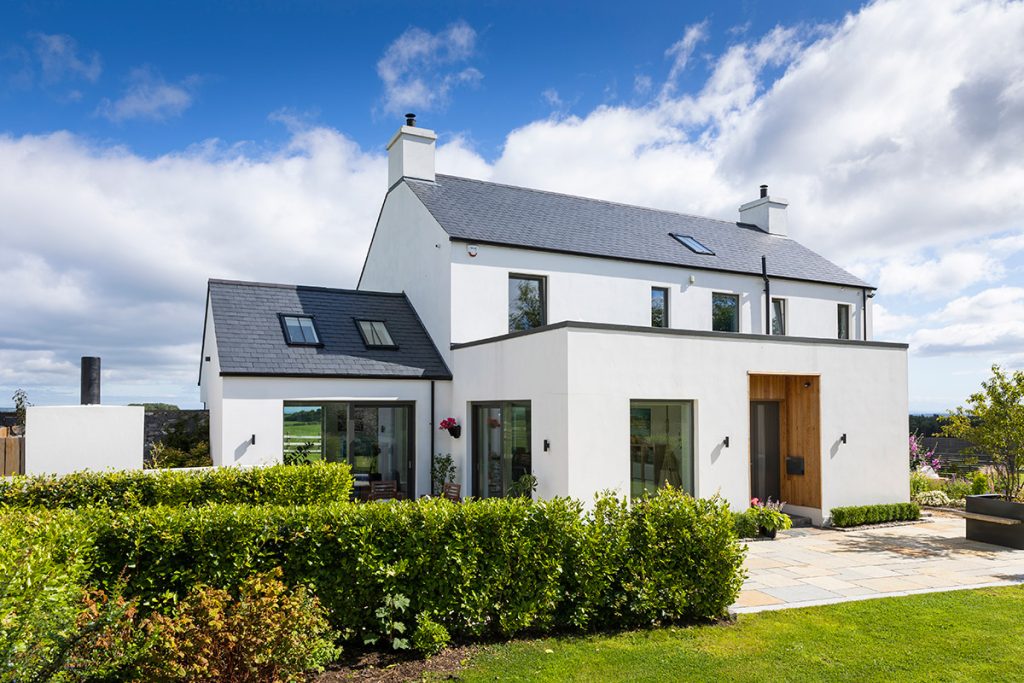
Traditionally, pitched roofs were described as cut roofs as they were built by a carpenter on site from bales of timber. Nowadays, most modern houses are built using prefabricated trussed rafters, which are produced off site and craned into position in a day. A detailed design by an engineer will be required to specify the layout of rafters, size of each rafter, bracing requirements, distance between each set of rafters, connection details, and fixings. The variance in these items from roof to roof can have a substantial impact on cost.
[adrotate banner="58"]Flat Roofs are defined as roofs with a slope of less than 10 degrees and are more common now than ever due to advances in flat roof finishing products. They are a more economical option than a pitched roof, particularly for large roof areas or complicated shapes. Flat roofs are usually built from timber joists and plywood or, in some cases, concrete. They are generally installed on-site in a similar manner to traditional cut roofs. There are three types of flat roof construction: cold roof deck, warm roof deck, and inverted warm roof deck. The warm roof deck system, where insulation is placed immediately below the waterproof covering and on top of the decking and vapor barrier, is the most common in Ireland.
Cold vs warm roofs
There are generally three different types of flat roof construction known as a cold roof deck, a warm roof deck or an inverted warm roof deck. The latter is uncommon in Ireland. A cold roof deck is where the insulation for the roof is installed below the level of the roof deck usually in the ceiling which keeps the roof deck and covering at a low temperature.
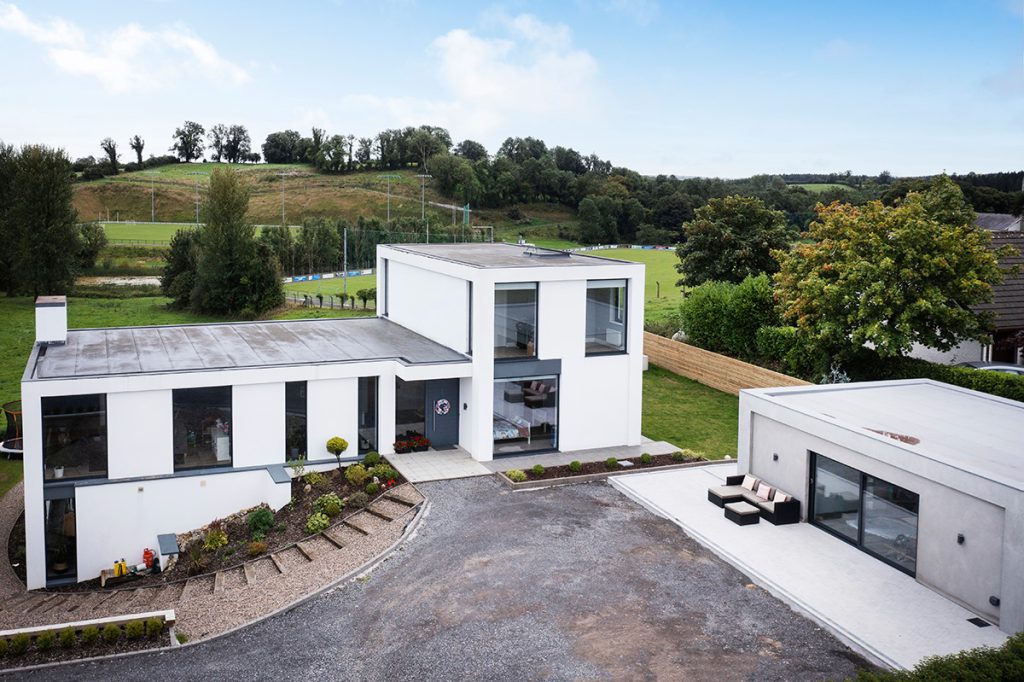
A warm roof deck places the insulation immediately below the waterproof covering and on top of the decking and vapour barrier. The deck is therefore kept at a warmer temperature during winter months. The warm roof deck system would be most common as it better controls the dew point.
The general downside to a flat roof structure is that it is generally the case that insurance companies rate a flat roof at a higher risk than a pitched roof. Care should be taken to review this issue with your current or future insurers to have full knowledge of the ongoing cost impact of this type of construction.
Cost comparison
The cost difference between pitched roof structures is minimal, but the speed of installation of prefabricated trusses makes them more popular. Flat roofs are more economical than pitched roofs for large roof areas or complicated shapes.
Note that there has been a 20 to 30 per cent increase across roofing costs since our last analysis three years ago.
Roof finishes
Most roof finishes will require additional layers of plywood, a vapour barrier or breather membrane, battens with or without counter battens, ventilation requirements, etc. The actual final cost of any particular makeup will be determined when the full design is individually reviewed and costed.
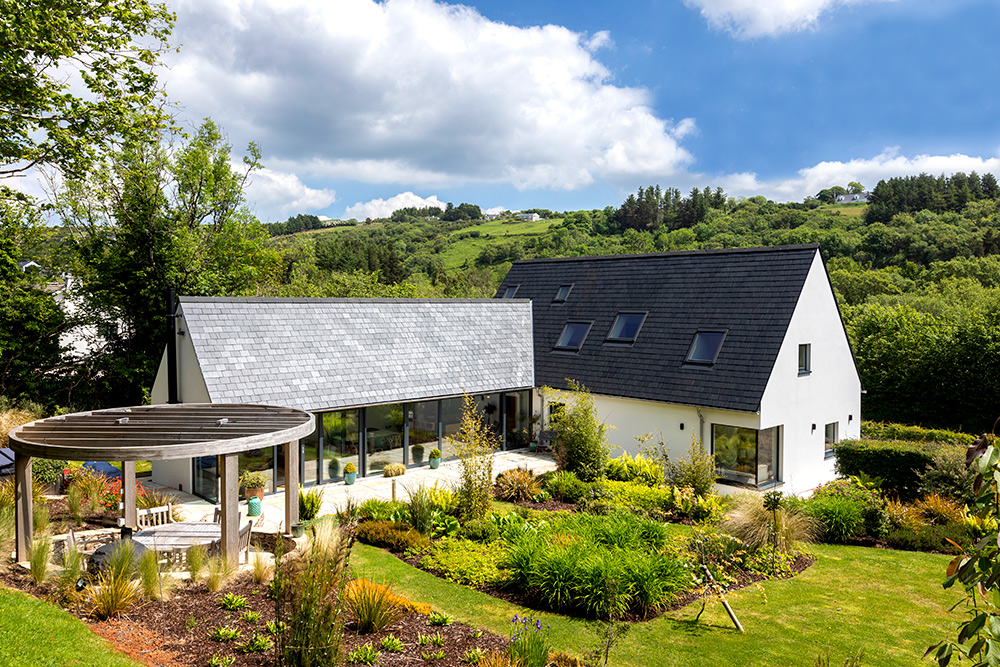
Flat roofs used to be covered with a mastic asphalt but it’s prone to leaking and now only really used on sheds, costing up to €30 to €40 per sqm.
The more common flat roof systems are uPVC or bitumen based. Layers include plywood, vapour barriers, insulation and the waterproofing layers. They are more controlled in temperature and can be easily worked around upstands, outlets and the likes, costing from €100 to €150 per sqm taking into account all aspects.
Fibreglass is a more recent addition to the roof finishes options and one that has become very popular. Costing from €70 to €85 per sqm for the all-in system, it’s economical and quickly installed. Again it is easy to work around upstands and openings.
The selection of a roof finish requires a view on cost per unit and working out the number of each unit required. As slates, tiles and other finishes all vary in size, as does the manner in which they overlap, in order to work out the cost of any finish it will be necessary to identify the number of units per sqm. By way of example a slate size of 500 x 250mm slate will on average require 21 slates per sqm whereas a 600 x 300mm slate will only require 13 slates per sqm on average.
As a result of the increase in the cost of natural slate, fibre cement slates and concrete tiles have become the more common choice for pitched roofs in the recent past.
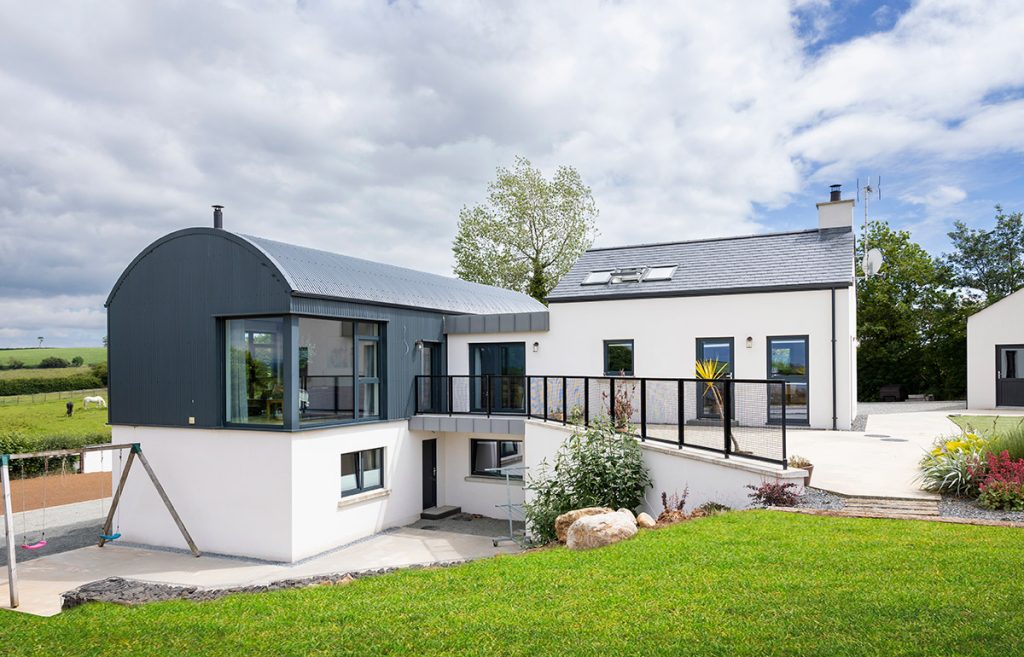
Natural slate Quality varies greatly. Traditionally the most renowned was the Welsh blue Bangor slate but due to issues with availability this product can now cost over €16 per slate (over €190 per sqm), with the majority of people now having to source it from salvage yards. The most common natural slate on the Irish market is of Spanish origin, from €30 to €40 per sqm, but Portugal and Brazil do supply similar or lower cost alternatives. Fibre cement slates used to contain asbestos but these were phased out in the 1980s.
Fibre cement slates come in a range of colours and as they are man made they are uniform in shape. Less durable than their natural cousins, they are relatively cheap and can be bought for less than €2 per slate (€24 per sqm on average).
Concrete Tiles are available from a range of suppliers, in a range of colours and designs. These products are man made and will generally be available for less than €2 per tile. The number of tiles per sqm varies greatly depending on how easy they are to install and can vary from as low as 8 per sqm to over 16 per sqm.
Other less common methods of coverings a pitched roof include wood shingles, thatch and sheet coverings (lead, zinc, copper or various forms of aluminium). As non-standard products they can be expensive, involve a lot of detailing and design. Metal based roof coverings are more common on flat roofs for visual appeal. They involve a great deal with detailing and joint work and will generally (depending on quantity, cutting and design) run to circa €250 per sqm all in.
Flat vs pitched
Cost difference on our sample 139sqm bungalow with all other elements left the same.
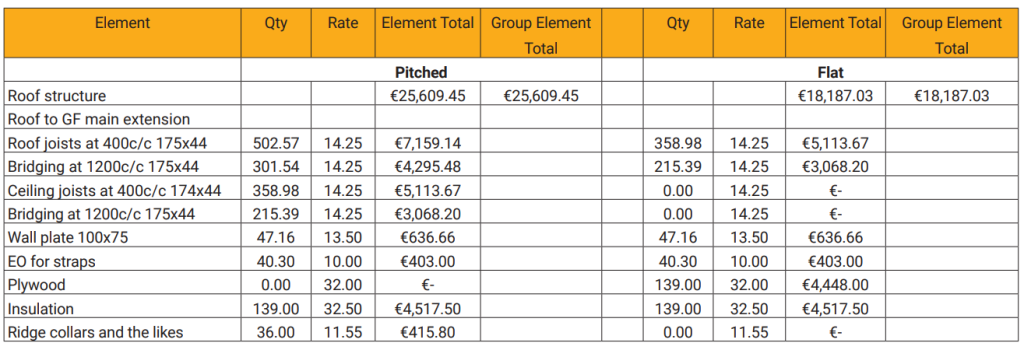
Bungalow vs two storey
Cost difference on sample 139sqm properties with concrete tile and pitched roof. The cost difference between the two properties where all rates are left the same, is over €10/sqft of floor area. This further shows the dangers of costing a property based on average costing.
